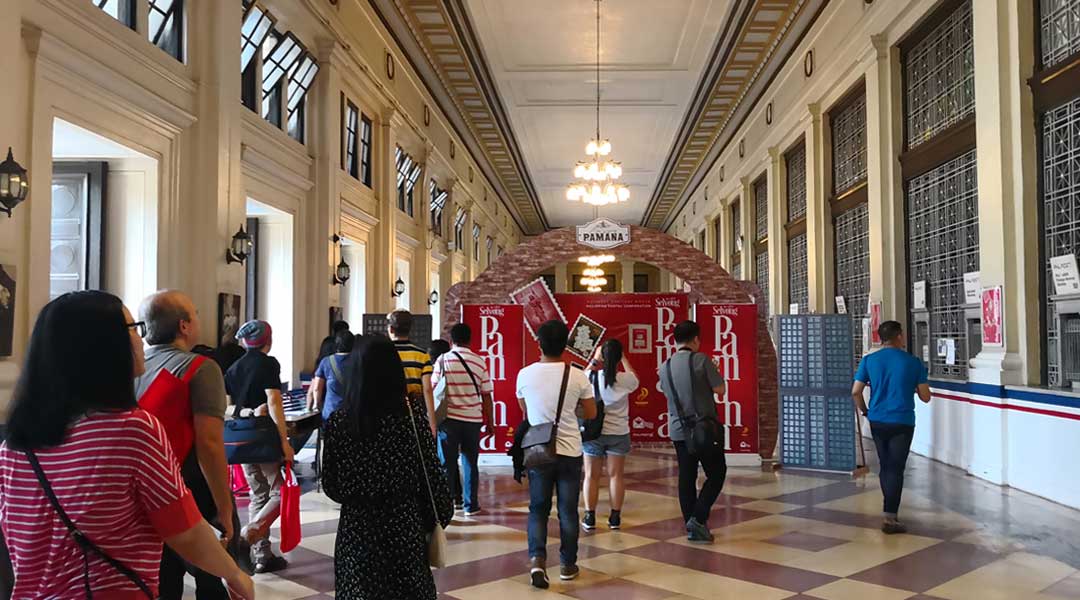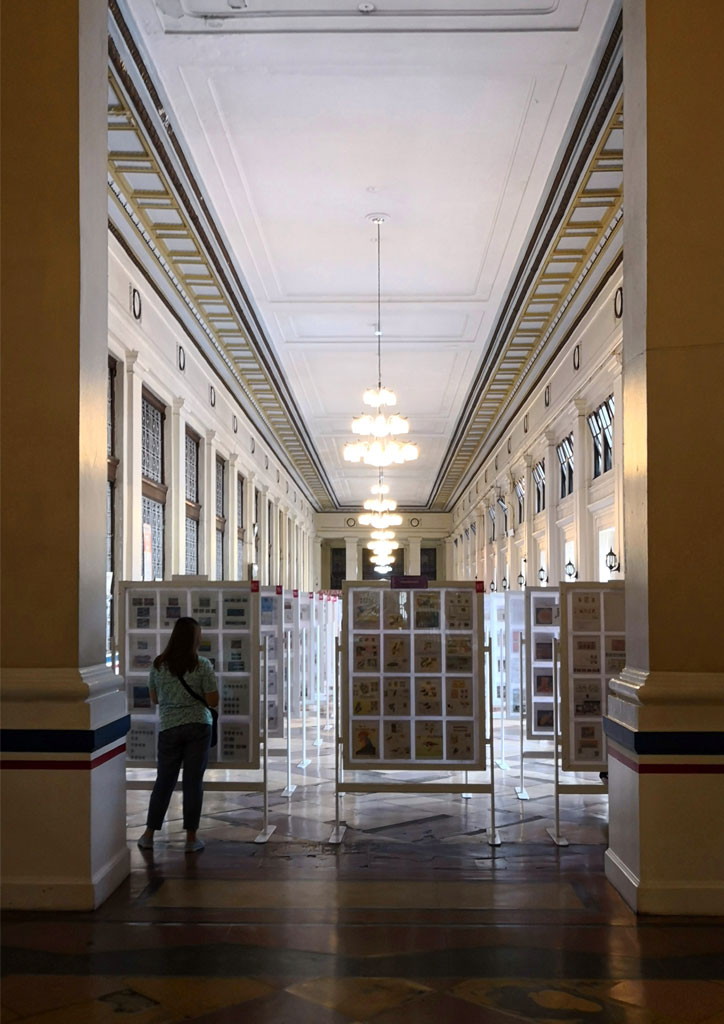
PHLPOST, NCCA host postal exhibit and tour for National Heritage Month
Pursuant to Presidential Proclamation No. 439 s. 2003, the National Heritage Month (NHM) is celebrated during the month of May of every year, to create consciousness, respect, and love for the legacies of Filipino culture and history. In celebration of the NHM, the Philippine Postal Corporation (PHLPOST) organized a guided tour at the Manila Central Post Office in conjunction with the postal heritage exhibit “Mga Selyong Pamana,” in collaboration with the National Commission on Culture and the Arts (NCCA) and Philippine Philatelic Federation last Saturday, 26 May.
“Mga Selyong Pamana” stamp exhibition
To promote the value of cultural heritage and its role in shaping the Filipino identity, PHLPOST and NCCA mounted “Mga Selyong Pamana,” a philatelic exhibition featuring special stamps from notable philatelic collectors in celebration of the National Heritage Month, with the theme “Pambansang Pagkakaisa Para sa Pamana,” from 21-28 May.

The exhibit showcased 40 frames with a total of 620 pages featuring Philippine stamps depicting Filipino cultures, traditions and great Filipinos. The first to the 27th frames in the exhibit display Philippine History in stamps. Frames 28-42, on the other hand, exhibit the milestones, geographies, and facets of Philippine postal service. Catholic traditions then and now are featured in frames 43-66, while Filipino contemporary events and personalities are highlighted in frames 67-76. The last frames 77-84 put spotlight on Philippine material culture and natural heritage.
“We support the effort of the NCCA to preserve and protect these cultural heritage which has been featured and officially recorded in these miniature pieces of Art called ‘stamps’ for the enjoyment of our future generations,” Postmaster General Joel Otarra said in a press release.
Housed at the historic Manila Central Post Office building in Liwasang Bonifacio, the opening of the exhibit was attended by philatelic collectors, partner government and private agencies. Dr. Jaime C, Laya, a business leader and known cultural heritage proponent was the guest of honor and speaker.
READ MORE: Riverside Palace Renewed: The Juan Luna Building
Inside the post office

The guided tour inside the historic Manila Central Post Office was spearheaded by the PHLPOST and art blogger and stamp collector Lawrence Chan of Walk with Chan Heritage Tour. It was attended by school children, bloggers, heritage and philately enthusiasts, and artists, with attendees from Vigan and Bulacan. The pre-registration of individual participants totalled 115, with more attendees on the day itself. The tour was also attended by Philippine Philatelic Federation president Reynaldo Ong de Jesus, museum curator Zenaida Trambulo, award-winning graphic artist and part owner of Papemelroti Robert Alejandro, to name a few.
READ MORE: Escolta Maestros: 6 Filipino architects who shaped the old CBD

On the spot registration started at 8:30am, which was followed by a short briefing and presentation by PHLPOST and Chan, in which they discussed the background and role of the post office, mails, and the stamps from decades ago to the current year. The tour started at the kartero office, where the postmen are stationed; across is another office where mails are sorted. The postmen’s section overlooks the Pasig River and the old Central Business District of Manila, while the sorting section has a view of the lobby where the “Mga Selyong Pamana” was on exhibit. From there, the participants were led to the third floor where the Postmaster General and other administrative offices, as well as a courtyard that functions as an events space, are located.

After a few flights of stairs below, participants were led to the “Lock Box,” commonly known as the P.O. Box area. The Lock Box that looks like a small locker, functions as a person’s alternative address. Anyone who rents a lock box will be given his or her own key to her box, where mails, parcels, and other items addressed to them will be sent. According to the tour guides, the are where the Lock Box is located used as torture and interrogation chamber during the Japanese occupation.
The tour ended with free snacks, stamp collecting, more stamp talks, and photo op with the neoclassical façade of the Central Post Office on the background. The current building was built from 1924 to 1926, and was designed by Ralph Harrington Doane, Tomás Mapúa, and Juan Marcos de Guzman Arellano.
READ MORE: Vernacularization in Philippine Modern Architecture (part 1)


Philippine colonial churches stamps
This year, PHLPOST also issued stamps to showcase the beauty and distinctive architecture of centuries-old Spanish colonial churches in the country. The stamps, in 12-peso denomination each, come in two sets: Block of Four and Souvenir Sheet.
The first set includes four designs: San Matias Church in Isabela, Santa Monica Parish Church in Panay Island, Santa Monica Parish Church in Pampanga, and Santa Catalina de Alejandrina Church in Abra. The Block of Four only has 50,000 copies. The second set includes six designs: San Carlos Borromeo Church in Batanes, Santa Catalina de Alejandrina Church in La Union, Nuestra Señora del Patrocinio de Maria Parish Church in Cebu, Nuestra Señora de la Asuncion in Ilocos Sur, Nuestra Señora de la Asuncion in Bohol, and Santo Tomas de Villanueva Parish Church in Iloilo. The Souvenir Sheet has only 4,000 copies
The special issue of stamps was designed by Victorino Z. Severo and coordinated with Judith Neric ng Filipino Heritage Festival Inc.. The stamps were released on 2 May and will be on sale until 1 May 2019.

Postal Museum in the works
Among the plans of the Postmaster General this year, is to open a Postal Museum at the lobby of the historic Manila Central Post Office Building. The office intends the Postal Museum to be an added attraction to the local and foreign tourists who frequently flock at the historic sites in the city of Manila. It will also be an academic facility for students and stamp collectors to learn and appreciate Filipino cultures and history.
If approved, the PHILATELIC Museum and Resource Center will be located at the left wing side of the main post office. There used to be an old Philatelic Museum and Library, located at the PHLPOST ANNEX Building, which was created in 1992 and was initially located at the upper level of the main post office until late 1995. It used to house artifacts like old typewriters and other equipment, which were relocated at the 3rd Floor PHLPOST ANNEX building until sometime in 2009. ![]()
READ MORE: Maestranza to become creative hub as Intramuros eyes UNESCO Creative Cities list
To sign up for the next post office tour, you may visit Royal Postal Heritage Guided Tour. You may also visit www.phlpost.gov.ph for more information on Manila Central Post Office.


